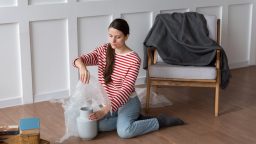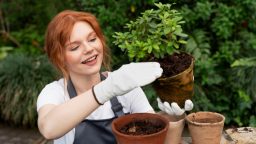Having an indoor herb garden is not only a great way to add fresh, flavourful ingredients to your cooking but also an easy and rewarding way to bring a bit of nature into your home. With a little planning and some care, you can grow your own herbs year-round, regardless of the weather outside. Whether you’re new to gardening or an experienced green thumb, creating an indoor herb garden is both fun and functional. Here’s a step-by-step guide to help you get started.
- Choose the Right Location
Herbs need plenty of sunlight to grow, so it’s important to find a suitable location in your home that receives enough light.
- Sunlight: Most herbs require 6-8 hours of direct sunlight per day. Look for a sunny windowsill that faces south or west. If your windows don’t provide enough light, you might want to invest in grow lights, which simulate natural sunlight.
- Temperature: Herbs generally thrive in temperatures between 60-70°F (15-21°C). Avoid placing your herb garden near heaters, air conditioners, or drafty windows, as extreme temperature fluctuations can affect their growth.
- Humidity: Herbs like a bit of humidity, but not too much. Keep them away from overly dry areas, such as near vents. If your home is dry, especially in winter, you can use a small humidifier or place a shallow tray of water near your plants to maintain moisture.
A bright windowsill is often the best spot for herbs, but if natural light is limited, using artificial grow lights can ensure your plants get the light they need.
- Select the Right Herbs for Indoor Growing
Not all herbs are suitable for indoor growing, as some require more space or sun than others. The following herbs are well-suited for indoor gardens and thrive in smaller spaces:
- Basil: This herb thrives in warm, sunny spots and requires regular harvesting to encourage bushy growth.
- Mint: A hardy herb that grows well indoors. Keep it in a separate container, as it can spread quickly.
- Thyme: A versatile herb that grows well in containers and enjoys a moderate amount of sunlight.
- Parsley: This herb can tolerate less light and is relatively easy to grow indoors.
- Cilantro: Ideal for indoors, but be aware that it tends to bolt (flower and go to seed) quickly in hot conditions, so it needs to be regularly harvested.
- Oregano: This herb thrives in direct sunlight and is perfect for growing indoors in pots.
- Chives: A hardy herb that does well in containers and requires minimal care.
When choosing herbs, think about your culinary needs as well. Fresh basil for pasta dishes or parsley for garnishing—select the herbs you use most frequently to get the most out of your indoor garden.
- Pick the Right Containers
When setting up your indoor herb garden, selecting the right containers is crucial for plant health. Proper drainage is key to preventing root rot and ensuring healthy growth.
- Containers with drainage holes: Ensure that the pots you choose have drainage holes at the bottom to allow excess water to escape. This helps prevent water from collecting at the base and suffocating the roots.
- Size of the pots: Select pots that are large enough for the herbs to grow comfortably. While herbs generally don’t need a lot of space, ensure the containers are deep enough for the roots to expand. Most herbs do well in 4-6 inch pots, but larger herbs may require bigger containers.
- Tray or saucer: To catch excess water, use a tray or saucer underneath each pot. This will help prevent water stains on your furniture and floors.
You can also get creative with containers—use anything from traditional terracotta pots to mason jars, wooden crates, or even repurposed items like old tea tins or wooden boxes.
- Use the Right Soil
For your indoor herb garden to thrive, it’s important to choose the right soil. Herbs require well-draining soil to avoid root rot and promote healthy growth.
- Soil type: Use a high-quality potting mix that is lightweight and well-draining. Avoid using garden soil, as it can become compacted in containers and doesn’t allow for proper drainage.
- Add perlite or sand: To improve drainage, you can mix some perlite or coarse sand into the potting mix. This will ensure that the soil doesn’t become too heavy or waterlogged.
When potting your herbs, be sure to leave about an inch of space between the top of the soil and the rim of the pot to prevent water from overflowing when you water the plants.
- Water Properly
Proper watering is essential to keeping your indoor herb garden healthy. Overwatering or underwatering can lead to stress, disease, and even plant death.
- Check the soil: Before watering, check the soil’s moisture level by sticking your finger about an inch into the soil. If it feels dry, it’s time to water. If it’s still moist, wait a day or two before watering again.
- Water deeply: When you do water, make sure to water thoroughly until the water drains out of the bottom of the pot. This ensures that the entire root system receives moisture.
- Avoid standing water: Make sure your pots are draining properly and empty any excess water that collects in the saucer to prevent the roots from sitting in water, which can lead to root rot.
Indoor plants typically need less frequent watering than outdoor ones, so be mindful not to overwater them, especially in the winter months when they’re not actively growing.
- Harvest Regularly
Regular harvesting encourages herbs to grow more vigorously. It also helps prevent them from flowering too early and going to seed, which can affect the flavour of your herbs.
- Pinch leaves: For most herbs like basil and mint, pinch off the top leaves regularly to encourage bushier growth. Be sure to leave the lower leaves intact to allow the plant to continue photosynthesising.
- Cut stems properly: When cutting herbs, always use sharp scissors or pruning shears to avoid damaging the plant. Cut the stems just above a pair of leaves to promote new growth.
- Avoid overharvesting: While it’s important to harvest regularly, avoid removing too many leaves at once. This can stress the plant and stunt its growth.
By regularly pruning and harvesting your herbs, you’ll help them stay healthy and productive, giving you fresh herbs all year round.
- Maintain Air Circulation and Humidity
Indoor plants, especially herbs, thrive with good air circulation and proper humidity levels. Without these, plants can develop mold or pests.
- Air circulation: Ensure that your herbs have access to fresh air and aren’t in a stagnant, closed-off environment. You can use a small fan to increase airflow in your indoor garden, especially if your space is stuffy or lacks ventilation.
- Humidity: Many herbs, particularly basil and parsley, prefer moderate humidity. If your home is dry, especially in winter, consider placing a humidifier near your plants. Alternatively, you can mist the leaves of your plants with water every few days.
Maintaining a balanced environment helps ensure your herbs grow well and remain free from pests or diseases.
- Be Patient
Growing an indoor herb garden takes time, and the growth rate of herbs can vary depending on the type of plant, the environment, and how well it’s cared for. While herbs like basil and mint may grow quickly, others like rosemary or thyme might take longer to establish themselves.
- Growth speed: Some herbs grow quickly, while others may need more patience, especially in the beginning stages. Don’t be discouraged if your herbs don’t grow as fast as expected.
- Seasonal changes: Keep in mind that the growth of your herbs may slow down in the colder months when the plant’s natural growth cycle is slower.
Be patient with your indoor herb garden, and remember that with the right care, your herbs will flourish and provide you with fresh, home-grown ingredients.
Conclusion
Creating an indoor herb garden is a rewarding experience that brings fresh flavours and a touch of nature into your home. By choosing the right location, containers, and soil, and providing the necessary care, you can easily grow a variety of herbs indoors, no matter the season. Whether you use them for cooking or simply enjoy their fragrance, your indoor herb garden will be a beautiful and functional addition to your home. Happy gardening!





